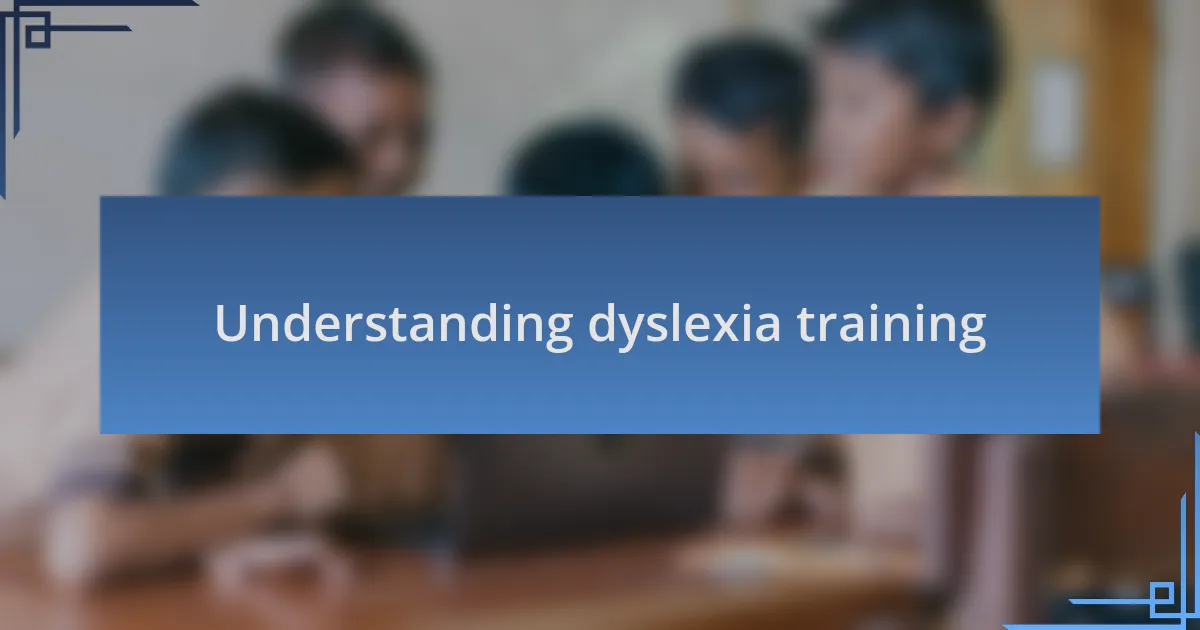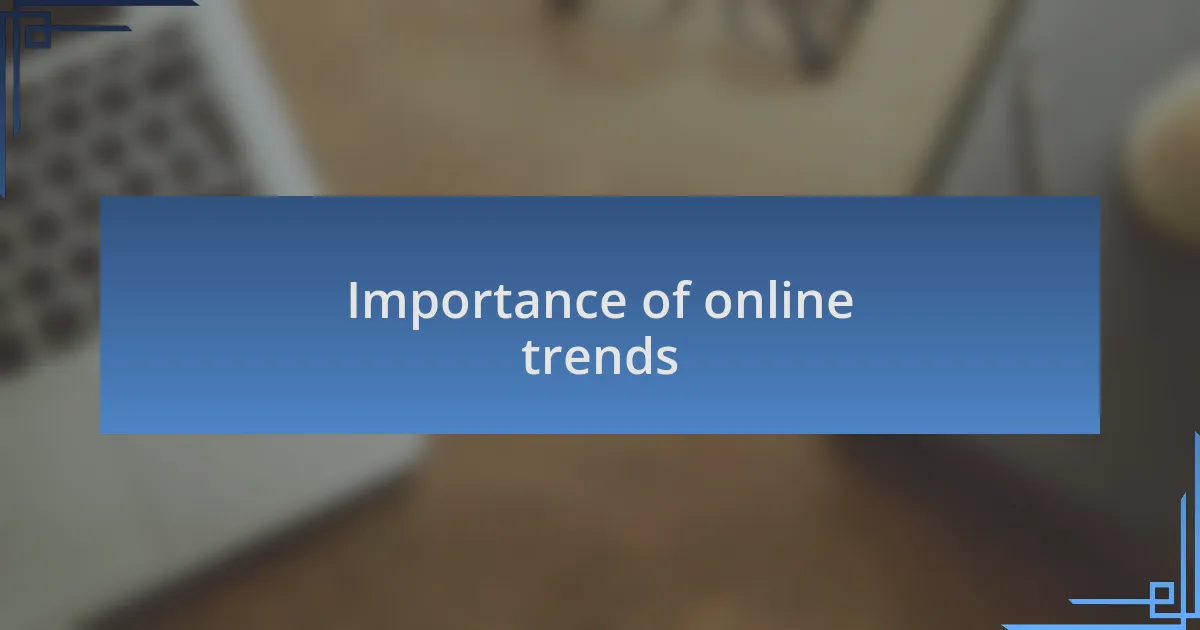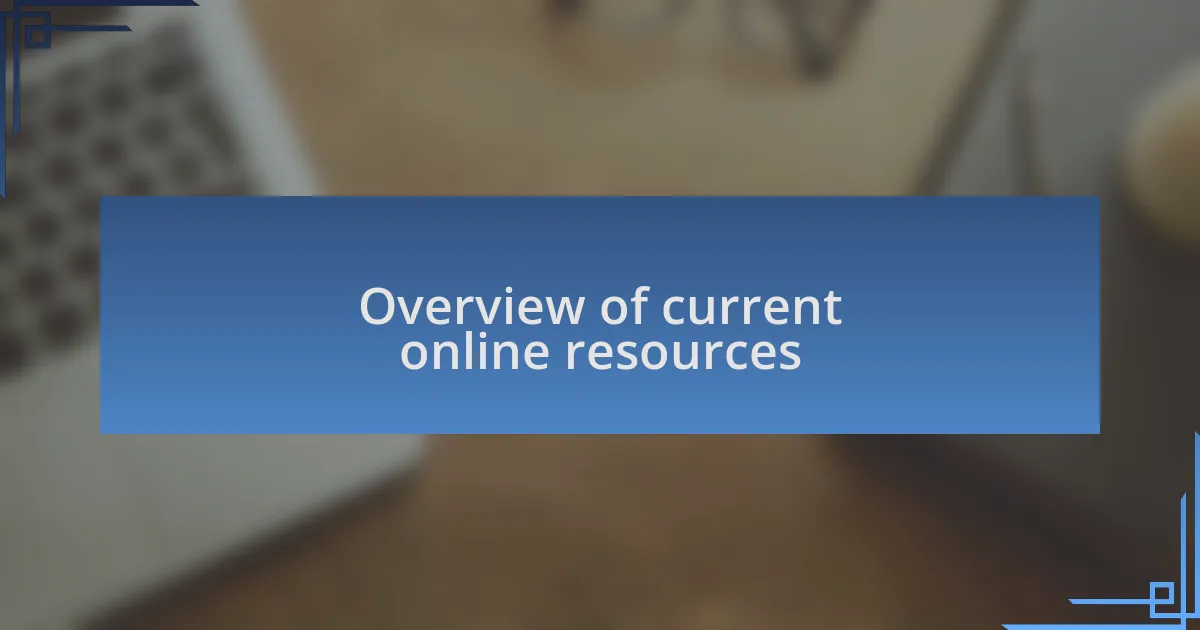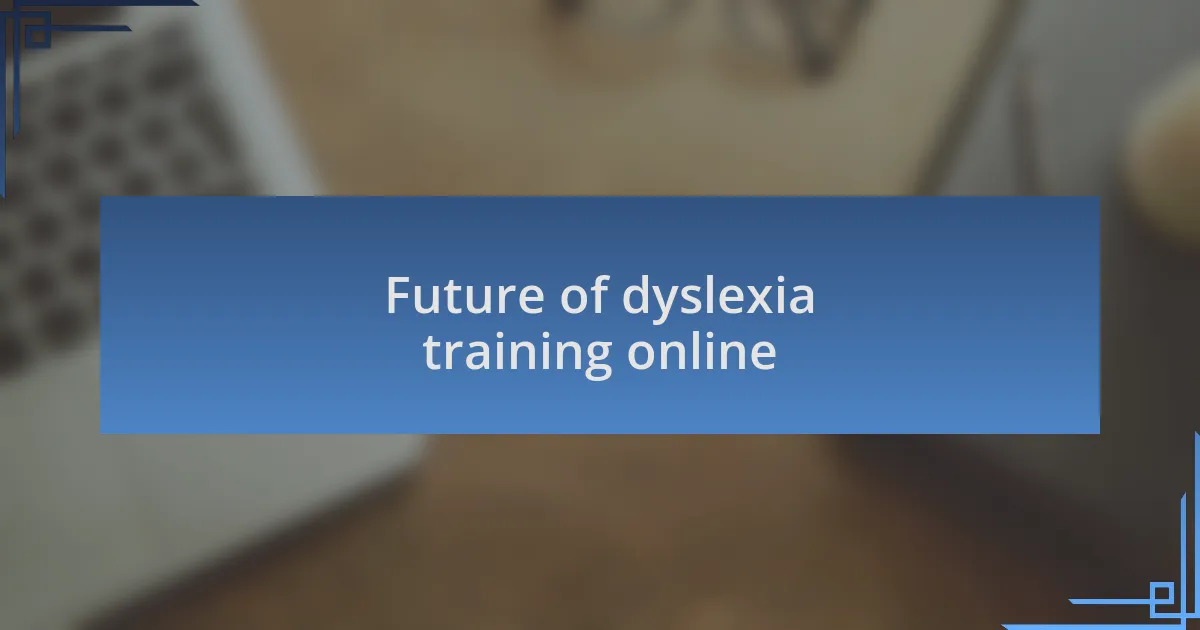Key takeaways:
- Dyslexia training requires tailored approaches, emphasizing multisensory techniques and emotional support to foster learning and confidence.
- Online resources and trends enhance dyslexia training by offering interactive tools, supportive communities, and personalized learning experiences through technology.
- Effective online programs incorporate gamification and progress tracking, making learning engaging and allowing students to visualize their achievements.
- The future of dyslexia training is likely to see advancements in personalized learning and the integration of virtual and augmented reality, enhancing engagement and practical application.

Understanding dyslexia training
When I first learned about dyslexia training, I was struck by how tailored it needs to be for each individual. Everyone’s experience with dyslexia is different, and this means that training methods must adapt accordingly. Have you ever considered how frustrating it can be to implement a one-size-fits-all approach to such a personal challenge?
The methods used in dyslexia training often focus on multisensory learning techniques, which I find incredibly effective. This means engaging multiple senses to help reinforce reading skills. I recall a moment when a student I worked with finally felt a sense of accomplishment after mastering a tricky sound because we approached it through games and music. That joy is a reminder of just how impactful the right training can be.
Moreover, the emotional support provided during training is just as crucial as the academic strategies. I’ve seen students transform not just as learners but as confident individuals when they feel understood and supported. Isn’t it amazing how a blend of empathy and technique can spark such profound change in someone’s life?

Importance of online trends
The relevance of online trends in dyslexia training cannot be overstated. With a wealth of resources at our fingertips, I’ve found that staying current with these trends opens up innovative approaches that can be game-changing. For instance, recently, I came across interactive apps designed specifically for dyslexic learners. These tools make practicing essential skills engaging and playful, turning what could be tedious exercises into enjoyable activities.
I remember participating in a webinar that focused on emerging online strategies for dyslexia support. The insights shared by experts were not only informative but also inspiring. It reminded me that as we leverage digital platforms, we’re not just educating ourselves—we’re actively breaking down barriers that have long held students back. Have you ever thought about how a single online trend can create ripples in a child’s learning journey?
Furthermore, these trends foster a community where sharing experiences and strategies flourishes. I’ve personally benefited from forums where fellow educators exchange success stories and effective techniques. It’s heartening to realize that we’re all part of a larger conversation, and the collective knowledge we share can transform the understanding and treatment of dyslexia. Isn’t it incredible how online trends can unite people with a common purpose?

Overview of current online resources
When exploring the current online resources for dyslexia, I find that a diverse range of platforms is available, each catering to various learning styles. For example, I recently discovered a website dedicated to offering free video tutorials that break down complex reading strategies into manageable steps. Watching these videos not only deepens understanding but also highlights real success stories of individuals who have thrived through these techniques. Have you ever come across a resource that completely changed your perspective on learning?
In addition to video content, I’ve been impressed by the surge of online communities focused on dyslexia support. These spaces offer more than just information; they provide a sense of belonging. I vividly recall joining a Facebook group where members exchanged inspiring stories about overcoming challenges. It was as if a light bulb went off for me, realizing that no one has to navigate this journey alone. Isn’t it reassuring to know there’s a supportive network out there for both educators and learners?
Furthermore, many dyslexia-focused websites now offer personalized learning plans powered by artificial intelligence. I once engaged with a platform that analyzed my instructional methods and suggested tailored techniques to improve student engagement based on their unique needs. This level of customization was eye-opening for me, as it underscored the potential of technology to enhance how we approach dyslexia training. Imagine the impact of having learning resources that evolve with our teaching styles!

Effective online dyslexia programs
When it comes to effective online dyslexia programs, I’ve seen the power of interactive tools firsthand. I remember working with a platform that included engaging games aimed at improving phonemic awareness. The sense of achievement I felt after each level made learning feel less like a chore and more like an exciting challenge. Have you ever noticed how gamification can transform a difficult task into something enjoyable?
Additionally, some online programs incorporate multisensory approaches, which I find incredibly beneficial. During a workshop, I encountered a program that combined auditory and visual elements, facilitating a deeper learning experience. These approaches resonate with students on different levels, and I believe they foster a more positive attitude toward learning. Isn’t it fascinating how incorporating different senses can lead to greater retention of information?
Moreover, I appreciate programs that utilize progress tracking features. I recently used one that allowed me to visualize my improvement over time. Each small victory felt like a milestone, reminding me that every step counts on this journey. Wouldn’t it be motivating to see your progress and celebrate every achievement, no matter how minor? This kind of feedback not only boosts confidence but also reinforces the understanding that growth is a gradual process.

Personal experiences with online learning
Online learning has been a significant part of my journey with dyslexia. I vividly recall the first time I logged into a virtual classroom designed specifically for learners like me. There was an immediate comfort in knowing that the environment was tailored to accommodate my unique learning needs. Have you ever experienced that sense of belonging when a platform truly understands your challenges? It turned a daunting process into one where I felt supported and empowered.
One aspect that struck me during my online learning experience was the flexibility it offered. Unlike traditional classrooms, I could learn at my own pace, which greatly alleviated my anxiety. I remember participating in live discussions where I could contribute my thoughts without the pressure of raising my hand in front of a crowd. Isn’t it amazing how the anonymity of a screen can encourage us to share our ideas more freely?
Another memorable experience was working on collaborative projects through online forums. I found it exhilarating to connect with other learners facing similar challenges. Sharing insights and strategies made me realize I’m not alone in this journey. Have you ever felt the camaraderie that comes from shared struggles? That sense of community in an online space validated my experiences and made the learning process much richer.

Recommendations for best practices
To foster a productive online learning environment for students with dyslexia, I recommend incorporating multi-sensory approaches into the curriculum. Personally, I have found that using visual aids alongside auditory elements enhances understanding and retention. For instance, platforms that allow the integration of videos, infographics, and interactive quizzes create a more engaging learning experience and accommodate diverse learning preferences. Have you ever noticed how a simple diagram can make a complex concept much clearer?
Establishing clear, consistent structures is another best practice that I’ve encountered as vital. When online modules have predictable layouts, it reduces cognitive overload and makes navigation feel more approachable. I remember how much smoother my learning process became when I was familiar with the structure of my courses. Isn’t it reassuring when you can focus on learning rather than scrambling to figure out where everything is?
Finally, providing regular feedback and opportunities for self-reflection can significantly enhance learning outcomes. In my experience, constructive feedback helps identify strengths and areas for improvement, while self-reflection encourages a deeper understanding of personal progress. I often found it rewarding to track my growth through periodic reflections, sparking a sense of accomplishment. Have you ever celebrated a small victory that reminded you of how far you’ve come?

Future of dyslexia training online
As we look ahead to the future of dyslexia training online, I believe we will see a rise in personalized learning experiences tailored to individual needs. Utilizing artificial intelligence and machine learning, platforms can adapt resources in real time, allowing for a more customized approach. I remember feeling more engaged in my learning when materials aligned with my abilities and preferences; it made a world of difference. Have you ever wished for a learning tool that understood you as an individual?
Another exciting development on the horizon is the expansion of virtual reality (VR) and augmented reality (AR) in dyslexia training. Imagining immersive environments where learners can engage with their reading materials could bridge the gap between theory and practical application. In my own experience, interactive scenarios have often provided clarity that static materials simply cannot. Think about how effective it would be to practice reading in a dynamic, simulated context!
Moreover, community-based learning will likely become more pivotal. Online training platforms can facilitate peer-support groups, making it easier for students and parents to share experiences and strategies. When I connected with others facing similar challenges, I found strength in community. Don’t you think that having a network of support can empower learners to tackle their journeys with more confidence?